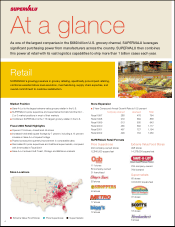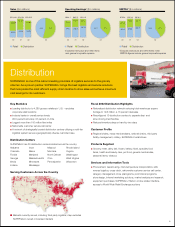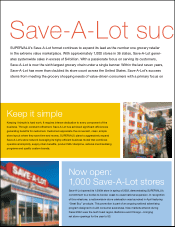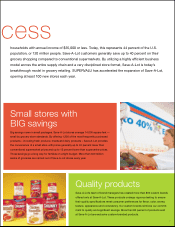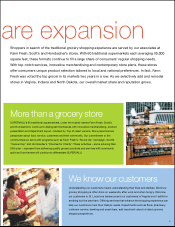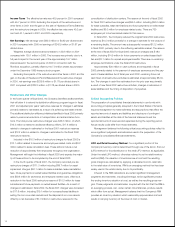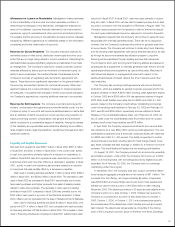Albertsons 2002 Annual Report Download - page 16
Download and view the complete annual report
Please find page 16 of the 2002 Albertsons annual report below. You can navigate through the pages in the report by either clicking on the pages listed below, or by using the keyword search tool below to find specific information within the annual report.
Income Taxes The effective tax rate was 46.9 percent in 2001 compared
with 45.7 percent in 2000. Excluding the impacts of the restructure and
other items in 2001 and the gain on the sale of Hazelwood Farms Bakeries
and the restructure charges in 2000, the effective tax rates were 40.2 per-
cent and 40.1 percent in 2001 and 2000, respectively.
Net Earnings Net earnings were $82.0 million or $0.62 per diluted share
in 2001 compared with 2000 net earnings of $242.9 million or $1.87 per
diluted share.
Weighted average diluted shares increased to 132.8 million in 2001
compared with 130.1 million in 2000. The increase was primarily due to a
full year’s impact in the current year of the approximately 19.7 million
shares issued in the second quarter of 2000 in connection with the
Richfood acquisition, partially offset by the 7.9 million shares repurchased
under the December 1999 treasury stock program.
Excluding the impacts of the restructure and other items in 2001 and the
gain on the sale of Hazelwood Farms Bakeries and the restructure charges
in 2000, net earnings were $235.9 million or $1.78 per diluted share in
2001 compared with $232.0 million or $1.78 per diluted share in 2000.
Restructure and Other Charges
In the fourth quarter of fiscal 2002, the Company identified additional efforts
that will allow it to extend its distribution efficiency program begun in fiscal
2001 and adjusted prior years’ restructure reserves for changes in estimates
primarily related to real estate as a result of a softening real estate market.
The additional distribution efficiency initiatives identified in fiscal 2002 primarily
relate to personnel reductions in transportation and administrative func-
tions. The total pre-tax restructure charges were $46.3 million, of which
$16.3 million is related to additional efficiency efforts, $17.8 million is
related to changes in estimates for the fiscal 2001 restructure reserves
and $12.2 million is related to changes in estimates for the fiscal 2000
restructure reserves.
Included in the $16.3 million of restructure charges for fiscal 2002 is
$13.1 million related to severance and employee related costs and $3.2
million related to lease cancellation fees. These actions include a net
reduction of approximately 800 employees throughout the organization.
Management will begin the initiatives in fiscal 2003 and expects the major-
ity of these actions to be completed by the end of fiscal 2003.
In the fourth quarter of fiscal 2001, the Company recorded pre-tax
restructure charges of $171.3 million including $89.7 million for asset
impairment charges, $52.1 million for lease subsidies, lease cancellation
fees, future payments on exited leased facilities and guarantee obligations
and $39.8 million for severance and employee related costs, offset by a
reduction in the fiscal 2000 restructure reserve of $10.3 million for lease
subsidies and future payments on exited leased facilities. As a result of
changes in estimates in fiscal 2002, the fiscal 2001 charges were increased
by $17.8 million, including $19.1 million for increased lease liabilities in
exiting the non-core retail markets and the disposal of non-core assets,
offset by a net decrease of $1.3 million in restructure reserves for the
consolidation of distribution centers. The reserve at the end of fiscal 2002
for fiscal 2001 restructure charges was $56.0 million, including $50.0 million
for lease subsidies, lease terminations and future payments on exited lease
facilities and $6.0 million for employee related costs. There are 750
employees yet to be terminated related to this reserve.
In fiscal 2001, the Company reduced the original fiscal 2000 restructure
reserve by $10.3 million primarily for a change in estimate for the closure of
a remaining facility. The amount was subsequently increased $12.2 million
in fiscal 2002, primarily due to the softening real estate market. The reserve
at the end of fiscal 2002 for fiscal 2000 restructure charges was $18.0
million, including $14.9 million for future payments on exited leased facili-
ties and $3.1 million for unpaid employee benefits. There are no remaining
employee terminations under the fiscal 2000 restructure.
Approximately $30 million in cash outflows are anticipated in fiscal
2003 primarily related to the payment of employee severance and the pay-
ment of lease liabilities. As of fiscal year end 2002, remaining future net
cash flows of all restructure activities is estimated at approximately $5 mil-
lion. The changes in cash flow estimates from the prior year are primarily
a result of new fiscal 2002 restructure activities, changes in estimates of
lease liabilities and the timing of disposition of properties.
Critical Accounting Policies
The preparation of consolidated financial statements in conformity with
accounting principles generally accepted in the United States of America
requires management to make estimates and assumptions that affect the
reported amounts of assets and liabilities and disclosure of contingent
assets and liabilities at the date of the financial statements and the
reported amounts of revenues and expenses during the reporting period.
Actual results could differ from those estimates.
Management believes the following critical accounting policies reflect its
more significant judgments and estimates used in the preparation of the
Company’s consolidated financial statements.
LIFO and Retail Inventory Method For a significant portion of the
Company’s inventory, cost is determined through use of the last-in, first-out
(LIFO) method for food distribution or the retail LIFO method, as applicable.
Under the retail LIFO method, otherwise referred to as the retail inventory
method (RIM), the valuation of inventories are at cost and the resulting
gross margins are calculated by applying a calculated cost-to-retail ratio
to the retail value of inventories. RIM is an averaging method that has been
widely used in the retail industry due to its practicality.
Inherent in the RIM calculations are certain significant management
judgments and estimates, including shrinkage, which significantly impact
the ending inventory valuation at cost, as well as the resulting gross mar-
gins. These judgments and estimates, coupled with the fact that the RIM is
an averaging process, can, under certain circumstances, produce results
which differ from actual. Management believes that the Company’s RIM
provides an inventory valuation which reasonably approximates cost and
results in carrying inventory at the lower of cost or market.
14


